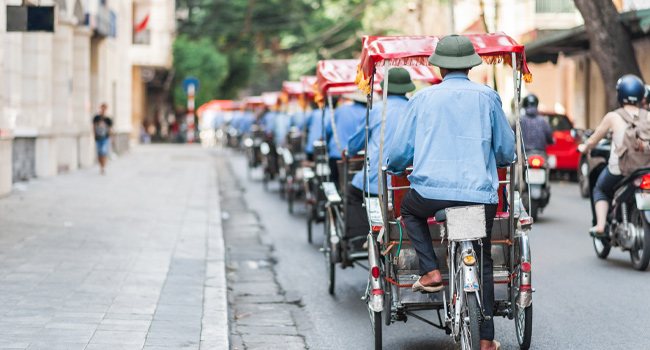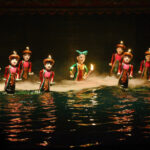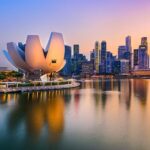The Trans Mongolian Railway holds a certain mystique for adventure travellers. It’s one of the classic overland routes like the Trans Siberian which keeps attracting curious travellers every year. Part of my job at Tucan Travel is to organise the accommodation and the trains for the clients travelling on our Trans Mongolian Railway tour, which operates from St Petersburg to Beijing or in reverse from Beijing to St Petersburg. At times due to irregular train schedules, huge hotel prices in Moscow, the complexities of obtaining Russian visas and language barriers my job can be very challenging so I was very excited to learn that this year I would get to go out there and see the outcome of all my long hours of work, and enjoy the experience so many of our clients have raved about.
Having previously visited St Petersburg and Moscow (that’s a whole other story!) I skipped this part of the trip and flew out to Irkutsk to join the group who had been travelling since St Petersburg. After a 45 minute transfer I checked into our hotel located in the village of Listvyanka right on the shore of Lake Baikal.
Once my eyes had adjusted to the sheer brightness of my surroundings it was quite clear to see that the lake (which stretches as far as the eye can see in almost every direction)was not a lake, it was in fact frozen solid. I sulked a bit inwardly as the whole area looked a bit quiet and I had sort of hoped to take a boat ride but I was reassured when I heard a strange humming noise and saw that some resourceful soul had brought a hovercraft and was whizzing around on top of the thick ice, packed full of tourists.
I met with the rest of the group for lunch with all of them talking at once about their favourite bits of the trip (they won’t mind me saying that!). It’s amazing on group tours how one small addition can change the dynamics and add a different perspective. I was particularly interested to know how the train from Moscow to Irkutsk went (I had heard various horror stories and I can only imagine the tedium of a 4 day train ride) but the group had nothing but praise, they even tipped the cabin attendant for all her hard work as the train was spotless! They had also met a lot of interesting travellers and locals taking the same journey and shared food and drinks and dodgy train window pictures (more about that later).
It also turned out that Listvyanka has plenty to do. There are two main museums, one of which houses two seals (everyone I met recommended a visit to this). There is the main souvenir market selling the mandatory fluffy seal (nerpa) and smoked fish which the group were raving about.
The hotel reception also showed us where a cable car runs up to Chersky cliff, or where we could go dog sledding or scuba diving. After exhausting many of our options we spent our evening on one of the many picnic tables dotted around the lakes shore looking out on to the lake watching the locals ride motorbikes and snowmobiles out on the ice and listening to it crack and grown ominously in the last of the sun.
We also had to make sure we had enough supplies for the train – my seasoned train experts advised me on what I would and wouldn’t require. The provision of hot water and western toilets on the trains are a certainty, however food is not always available.
We collectively bought the following (not necessarily in order of importance): Loo roll (toilet paper to those not from the UK), vodka, beer, drinking water, juice, noodles in a bowl – various types, mashed potato in a bowl, soup, porridge, fruit, biscuits, chocolate (large amounts) a knife, and a small stuffed sheep to become affectionately known as ‘sheepie’.
Once the novelty of fitting into the cabin with back packs on, trying to get them off and store them and arranging our belongings into our little sleeping compartment had worn off we nursed any injuries from various kicks and elbows from flailing arms and legs. Then we started exploring the train and the group introduced me to dodgy train pictures.
The scenery cannot be denied of its uniqueness and beauty but it does begin to look very samey after several hours.
We passed very little in the way of civilisation and when we did we were compelled to take as many pictures as possible, all of which were misted by the windows and blurred by dust or movement then we showed them proudly to each other. At the next stop we decided we should maybe use a wet wipe to clean the windows.
Other than drinking and eating we mastered various train pastimes such as washing our eating appliances, plucking of eye brows, putting make up on, braiding hair (girls mainly), loosing sheepie then finding her, remaking the bed, re arranging supplies and belongings, checking the toilet is still there and clean, reading the time table on the wall and guessing where we are. All of which we reported to each other and other train passengers in a kind of running commentary so there was hardly any time for reading to be honest.
The Russian/Mongolian border is what it is; trains on average take between 5 and 10 hours with the train standing on the platform. There is no point trying to find any reason or rhyme to the process, passports are checked, forms given out, cabins checked all in no particular order, even the locals on the train didn’t know what was going on. So we sat back with a few drinks from the one shop located close to the train station and observed the various officials studying us and did as were told.
We arrived in Ulaan Baatar, Mongolia’s capital and after a well deserved wash and a breakfast consisting of anything but noodles we set about sightseeing with our guide.We visited various monasteries, monuments and markets and became familiar with the city which is friendly and easy to orientate yourself to.
That evening on our guides recommendation we go to watch a traditional dance performance which includes throat singing, a strange, almost haunting but not unpleasant phenomenon to western ears.
The next morning we jumped into the van and head out to Terelj National Park. On the way our guide chatted freely, answering all of our weird and wonderful questions on life in Mongolia. We passed a ski resort an Irish pub, a pool hall, a British pub and various pizza establishments. It turns out a lot of American and Koreans visit Mongolia and they like to have these things. Mongolia’s primary industry has become mining of coal and gold and its attracting a lot of foreign investment, particularly from America and Australia. There was also a surprising amount of dead cattle and sheep. A lot of the population are relocating into the city to work for the big mining companies rather than continuing their normal nomadic way of life.
As we drove it was clear to see that that most people have built houses but keep their ger in the back garden as well. From what I can understand from our guide’s response the house with a fence is the permanent residence for the winter and then in summer they can take the ger out to good pasture with the animals and keep moving around as required.
We arrived at the winter residence of the family our guide wanted us to meet, and instantly felt were intruding but we were warmly welcomed into the main ger to sit around the main table.
There’s salty tea and dried milk sweets which aren’t sweet and difficult to describe, and bread. I don’t know what I expected but there’s a surprising amount of room inside and it’s very warm. There was a large fridge (with a London tube station magnet on) and plug sockets as well as photos of her family who live in the city.
The lady owner’s husband had died so her family are taking turns to come out and stay with her and by receiving visits from tourists she is able to supplement her income. I wondered if we should have brought the lady a gift but the guide said the lady was very proud and wouldn’t want charity, nor a house full of tat, although she likes the fridge magnet we could see!
As were about to leave the lady’s son asked the guide if we wanted to see their animals so we followed him into another ger which was dark with a stove burning in the corner and much warmer than the house.
Sitting quietly are 3 calves – they are 4 days old and it’s too cold for them (the winter has been particularly bad this year, hence the dead livestock by the road). There also lambs which are a bit older wondering around a pen. Anyone would think we had never seen farm animals before, cooing and taking photos and the lambs are loving it, chewing camera cases, clothing and weeing on shoes.
We arrived at the tourist camp, met by 3 dogs and shortly behind the owners. We were all shown to our gers and couples stay together but single girls and boys must otherwise stay separately. Each ger has 4 beds around the edge, a stove (by stove I mean wood burner), a wardrobe, table and little stools, the main theme of the decor is orange with traditional decoration.
We were free to take ourselves hiking, horse riding or we could stay around the camp playing billiards or table tennis. Horse riding is an experience, I seem to have the skinniest horse yet I am not the skinniest in the group. I was assured that although the horses are small they are strong and very capable of taking our weight, but after half an hour my horse has stopped a few times and nayed a bit and Mr Mongolian horse man has smacked its bottom to make it move. Not wishing to be the fat tourist that kills the horse I got off to walk with it which made it instantly more cheerful.
We also walked extensively around the camp and the surrounding area, where we saw some pretty spectacular landscapes. I got quite obsessed with taking pictures of the amazing rocky outcrops everywhere.
No matter where we went the dogs weren’t far behind, not really wanting to be petted but just happy to loiter behind and make sure the daft tourists don’t get lost – they seem to think we’re very similar to cows.
After another afternoon in Ulaan Baatar and a very large Mongolian BBQ (all you can eat), we boarded the early morning train to Beijing. We quickly reverted into our train routine of taking bad photographs and discussing the cleanliness of the toilet after each visit. We also bumped into other travellers doing the same route, some with other operators and some independently but we have been reunited on each train so far. At the Mongolian/Chinese border we were hoisted up high above the ground whilst the bogies were changed (he he) to fit the Chinese rail tracks. All the men on the train took pictures and passed comment pretending they knew what was going on, while most of the women just went to bed, or ate.
On arrival in Beijing it was quite clear we’d returned to reality, it’s chaotic in comparison to Ulaan Baatar.
We were met by our guide and taken to our hotel before we went out to have a look around Tiananmen Square and Chairman Mau’s mausoleum before going out for Peking Duck and trying out our chopsticking skills.
For an uncultured northern girl such as myself this is beyond my mentality, surely the point of a food carrying utensil is to get as much into your mouth as possible. I’m dropping food everywhere into drinks, onto other peoples plates, underneath the table, no wonder Chinese people aren’t tubby!
We were up bright and early the next morning and off to the Great Wall at Jinshanling. We’d bought our supplies the previous night for our Great Wall picnic and whilst shopping for our sandwich contents I discovered a strange thing – Chinese people don’t like cheese they think it’s silly and smelly. Our guide told me so himself screwing his face up to convey his disdain. The silly and smelly bit was probably a personal comment but another thing I’ll never understand.
Focusing back on to one of the man made wonders of the world, we walked for approximately 4 hours from Jinshanling to Simitai and to be honest we hardly saw any other tourists but we did meet various local ladies selling tshirts, drinks, chocolate, hats and various wall related souvenirs.
It’s quite a tiring walk in some places and the terrain gets steep and uneven. In contrast some stretches have been renovated and are smooth.
The views are spectacular and for me it was one of those “I can’t believe I’m here” places. I loved every second but my photos really couldn’t capture its sheer magnitude so after a few shots for Mum I focused on filling up the memory chip in my head.
Unfortunately my time in Beijing was limited so I’ve promised myself I’ll return, I’m sure China has a lot more to offer (I’ll be sure to pack a fork and some cheese though!)
Zoe’s top 3 tips for the Trans Mongolian Railway
1. Allow yourself more time in Beijing – you’ll really love it there and there’s heaps to see and do so make sure you book some extra accommodation for before or after your train journey
2. It would be handy to take a bottle opener for the train – the door frame works though if you don’t have one (I’m probably not supposed to say that…)
3. Learn a bit of Russian, it will be more fun to be able to speak to the locals – at the very least take a phrasebook. A picture book where you can point at things would be a great idea.
Spread the love



